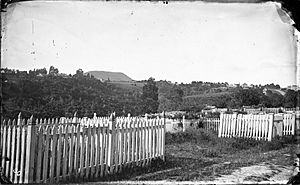Symonds Street Cemetery facts for kids
Symonds Street Cemetery is an old cemetery and park in the middle of Auckland, New Zealand. It covers about 5.8 hectares (which is like 14 acres) and is filled with trees that lose their leaves in autumn. The cemetery is located near Symonds Street and Karangahape Road, and the Grafton Bridge crosses over it.
The street and the cemetery are named after William Cornwallis Symonds. He was a British Army officer who played an important part in the early days of New Zealand becoming a British colony. This cemetery is listed as a Historic Place - Category I by Heritage New Zealand. This means it's a very important historical site. The Auckland Council takes care of the cemetery.
Contents
History of Symonds Street Cemetery

Symonds Street Cemetery was the first official cemetery in Auckland. People started using it in 1842. When it first opened, it was split into different areas for various religious groups. There were sections for Anglicans, Catholics, and Jewish people. There was also a shared area for Presbyterians, Wesleyans, and others.
By 1852, the shared area became just for Presbyterians. A new section was then added for Wesleyans and other general burials.
Changes Over Time
In 1886, a new, larger cemetery called Waikumete Cemetery opened in West Auckland. After this, Symonds Street Cemetery stopped selling new burial plots. Only families who already had plots could continue to bury people there. In 1909, the Auckland City Council took over managing the cemetery.
A big change happened in the mid-1960s when the Auckland Southern Motorway was built. Because of this, parts of the cemetery land were needed for the motorway. More than 4,100 bodies were carefully moved and reburied in two special memorial areas within the cemetery. The cemetery's total size became about a quarter smaller.
During this move, workers found many graves. In the Anglican section, they found about 2,000 graves under 1,200 headstones. In the Catholic section, there were 2,100 graves under 400 headstones. Many of Auckland's first European settlers are buried here. This includes William Hobson, who was the first Governor of New Zealand and helped write the Treaty of Waitangi.
Looking After the Cemetery
Over the years, there have been concerns about the cemetery's condition. A newspaper writer named Brian Rudman often wrote about the cemetery needing more care. He asked the city council to improve its upkeep.
In 1996, the Auckland City Council created a plan to help preserve the cemetery. However, only some of the ideas from this plan have been put into action. The Council does hire a special stonemason to fix old gravestones. But sometimes, these restored gravestones get damaged again.
Security guards patrol the cemetery sometimes to try and prevent damage. However, it has been hard for them to stop all problems.
Important People Buried Here
Many notable people from New Zealand's early history are buried at Symonds Street Cemetery. Here are a few of them:
- Archibald Clark (1805–1875): He was the first Mayor of Auckland in 1851.
- Edward Costley (1794–1883): A wealthy landowner who gave a lot of money to help others.
- Thomas Henderson (1810–1886): A successful business person who gave his name to the suburb of Henderson.
- William Hobson (1792–1842): The first Governor of New Zealand and a key person in the Treaty of Waitangi.
- William Hulme (1788–1855): An officer in the British Army.
- Henry Keesing (1791–1879): An early settler, business owner, and community leader.
- Frederick Edward Maning (1812–1883): A writer and a judge in the Native Land Court.
- Frederick Merriman (1818–1865): A Member of Parliament (MP) in New Zealand's first two Parliaments.
- David Nathan (1816–1886): A merchant and an important leader in the Jewish community.
- Thomas Peacock (1837–1922): An optician who also served as Mayor of Auckland and an MP.
- Philip Philips (1831–1913): The first Mayor of Auckland City (from 1871 to 1874).
- George Dean Pitt (1772–1851): He was the Lieutenant-Governor of New Ulster Province.
- Annie Jane Schnackenberg (1835–1905): A missionary and an activist who worked for women's right to vote.
- John Sheehan (1844–1885): An MP from 1872 to 1885.
- Charles Southwell (1814–1860): A writer from England who believed in free thinking.
- Charles de Thierry (1793–1864): An adventurer who tried to create his own country in New Zealand before it became a British colony.
- Henry Tucker (1793–1850): A Royal Navy officer and the first colonial storekeeper.


